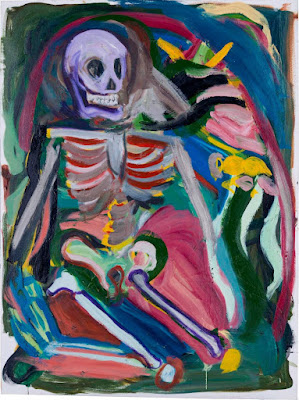-Kunstbibliothek-Staatliche-Museen-zu-Berlin.jpg) |
| Stephan Krotowski Irrigal Tabletten ca. 1910 lithograph (poster) Kunstbibliothek, Staatliche Museen zu Berlin |
 |
| Kjell Abramson Family Picture ca. 1960 oil pastels on paper Moderna Museet, Stockholm |
-Museum-Folkwang-Essen.jpg) |
| Martin Kippenberger Gerd + Martin Kippenberger Sand in the Vaseline 1986 screenprint (poster) Museum Folkwangm, Essen |
 |
| Alessandro Allori Portrait of a Woman ca. 1570-80 oil on canvas Saint Louis Art Museum |
-Oslo.jpg) |
| Hanne Borchgrevink Shed 1990 acrylic on canvas KORO (Public Art Norway), Oslo |
 |
| Anonymous Russian Artist Every contribution to the consumer cooperative is a step on the road to the Socialist transformation of the countryside 1931 lithograph (poster) Moderna Museet, Stockholm |
 |
| Lovis Corinth Inn Valley Landscape 1910 oil on canvas Alte Nationalgalerie, Staatliche Museen zu Berlin |
 |
| Roar Wold Red Room 1972 acrylic on canvas Nasjonalmuseet, Oslo |
 |
| Louis-Georges-Eléonor Roy Figure in Moonlight 1887 gouache on paper Norton Simon Museum, Pasadena |
 |
| Josh Smith Untitled 2012 oil on canvas Moderna Museet, Stockholm |
 |
| Sam Francis Keep Smiling 1974 acrylic on paper Moderna Museet, Stockholm |
 |
| Marsden Hartley White Top Mountain, New Hampshire 1930 oil on board Carnegie Museum of Art, Pittsburgh |
 |
| Henri Matisse Moroccan Landscape 1912 oil on canvas Moderna Museet, Stockholm |
 |
| Carl Moll Blooming Lilac in Heldenplatz, Vienna ca. 1900 oil on canvas Belvedere Museum, Vienna |
 |
| Thomas Theodor Heine Portrait of publisher Albert Langer in his Garden 1905 oil on panel Lenbachhaus, Munich |
 |
| Fanny Hjelm Early Summer Bouquet 1940 watercolor and gouache on paper Prins Eugens Waldemarsudde, Stockholm |
Half a mile outside the village, they embraced for the last time, Kalasiris the men, Charikleia the women, and clasped right hands, praying, amid a flood of tears, that better fortune would attend their parting. Knemon asked them to forgive him for not accompanying them, having but recently embarked upon the estate of matrimony; he said he would catch up with them if the opportunity arose – but he did not mean it. Then they parted. Knemon, Nausikles, and the rest returned to Chemmis, but the first action of Charikleia and Kalasiris was to change their clothes and adopt the guise of beggars, using rags they had ready for this purpose to turn themselves into paupers. Then Charikleia befouled her face, smearing soot and daubing mud on it to make it dirty, and arranged a filthy shawl skew-whiff on her head so that the edge of it hung down over one eye like a crazy veil. Under her arm she slung a pouch, apparently to serve as a receptacle for bits of bread and scraps of food, though in fact it had the more important function of containing her sacred Delphic robe and crown and the treasures and tokens of recognition that her mother had laid beside her when she was abandoned. Kalasiris wrapped Charikleia's quiver in some tattered bits of sheepskin and carried it slung crosswise over this shoulders as if it were merely another bit of baggage. He unstrung her bow, and, as soon as it had straightened out, he held it like a staff, leaning on it with all his weight; and whenever he saw that he was about to encounter someone on the road, he assumed a stoop even greater than his years compelled and developed a limp in one leg; sometimes he had Charikleia lead him by the arm.
– Heliodorus, from The Aethiopica, or, Theagenes and Charikleia (3rd or 4th century AD), translated from Greek by J.R. Morgan (1989)